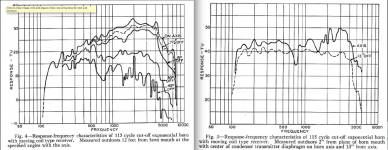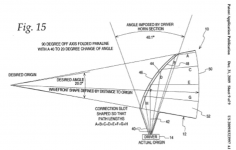The spiral horns like the Sato or Western Electric can be good on axis, but off axis wildly different.Wasn't the gist of the thread some page's ago, that only a Sato horn fold or a Western Electric 1 fold horn would not be detrimental to the midrange 🙂
This thread kind of lost steam after Speaker Dave posted some measurements of Western Electric response curves in post #1010:
http://www.diyaudio.com/forums/mult...-how-far-have-we-come-last-100-years-101.html
Attachments
I like the recordings of the western electric 15a on youtube. I see (hear) why people pay so much for them. But he's crossing around 300hz I think.
penndan22's channel - YouTube
He has the same recordings on different speakers (sometimes). The quad is close to the 15a, but no dynamics especially on saxophone. You can tell the exact amount of mouth variation on the reed when playing a saxophone. Comparing the 15a to most anthing else there, everything sounds wrong, specially small speakers with diffraction fronts, no bass also.
MVI 1348 - YouTube
MVI 1324 - YouTube
DIY WE 15A horn - YouTube
DIY Western Electric 15A horns ll - YouTube
DIY Western Electric 15A horns - YouTube
MVI 1351 - YouTube
Detail, dynamics, and time alignment from 300hz up (I think). Awesome.
But we are still talking a bass horn 150hz - 1,000hz, right ?????
I think a straight front horn (while deep) is the best way to go.
If you were only going to 400hz, then Lascala or J-horns would be fine.
Norman
penndan22's channel - YouTube
He has the same recordings on different speakers (sometimes). The quad is close to the 15a, but no dynamics especially on saxophone. You can tell the exact amount of mouth variation on the reed when playing a saxophone. Comparing the 15a to most anthing else there, everything sounds wrong, specially small speakers with diffraction fronts, no bass also.
MVI 1348 - YouTube
MVI 1324 - YouTube
DIY WE 15A horn - YouTube
DIY Western Electric 15A horns ll - YouTube
DIY Western Electric 15A horns - YouTube
MVI 1351 - YouTube
Detail, dynamics, and time alignment from 300hz up (I think). Awesome.
But we are still talking a bass horn 150hz - 1,000hz, right ?????
I think a straight front horn (while deep) is the best way to go.
If you were only going to 400hz, then Lascala or J-horns would be fine.
Norman
This thread kind of lost steam after Speaker Dave posted some measurements of Western Electric response curves in post #1010:
http://www.diyaudio.com/forums/mult...-how-far-have-we-come-last-100-years-101.html
On axis at 12 feet based on this graph the WE horns would be basically garbage in my room. I'm glad I didn't take that trip to Jersey to find out
I don't know I'd have the room at the moment, but maybe one day 🙂
Well, I've been fiddling with bending the horn again, and I wasn't really that happy with attempting to put something like a Sato horn together.
Still, I tried the below, thinking that the driver chamber could function also as a rear support that could help position the horn at a more appropriate angle.

The kink is quite sharp, but I guess it wouldn't take much to add a small panel to the back bend, and something similar on the inside. Using that bend takes the linear length of the horn unit down to 58.55cm.
Well, I've been fiddling with bending the horn again, and I wasn't really that happy with attempting to put something like a Sato horn together.
Still, I tried the below, thinking that the driver chamber could function also as a rear support that could help position the horn at a more appropriate angle.

The kink is quite sharp, but I guess it wouldn't take much to add a small panel to the back bend, and something similar on the inside. Using that bend takes the linear length of the horn unit down to 58.55cm.
Last edited:
Using that bend will fink up the sound hard.I
Using that bend takes the linear length of the horn unit down to 58.55cm.
Go back to 1984 when Dave Gunness figured this stuff out, substitute a parabola (you have heard of parabolic dishes, right) for the 45 degree angle below, and you will have something that works "much like" a straight horn.
Art
Attachments
Ah, I understand. I'll have to play around a bit more with parabolic curves...

How much does the expansion of the horn affect this curve?
It almost seems like it would be better to have segments of the horn that are straight for expansion purposes, and then have a uniform curve at chosen points...

How much does the expansion of the horn affect this curve?
It almost seems like it would be better to have segments of the horn that are straight for expansion purposes, and then have a uniform curve at chosen points...
Right, for widest BW, a fibonacci spiral is the ideal, though it can be rearranged with excellent results when done right.
GM
A fibonacci spiral also appears in a couple of other places:

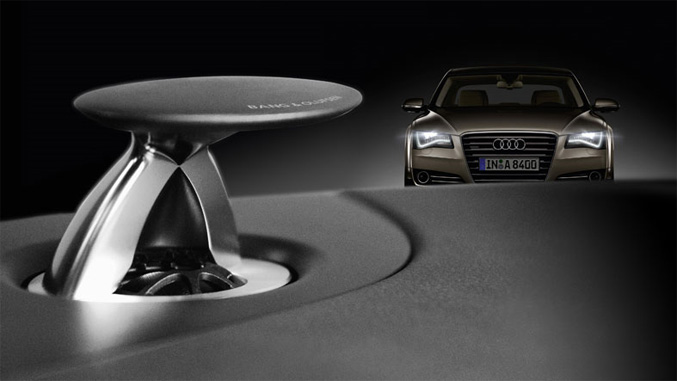
1) The B&O lens, designed by Sausalito Audio Works
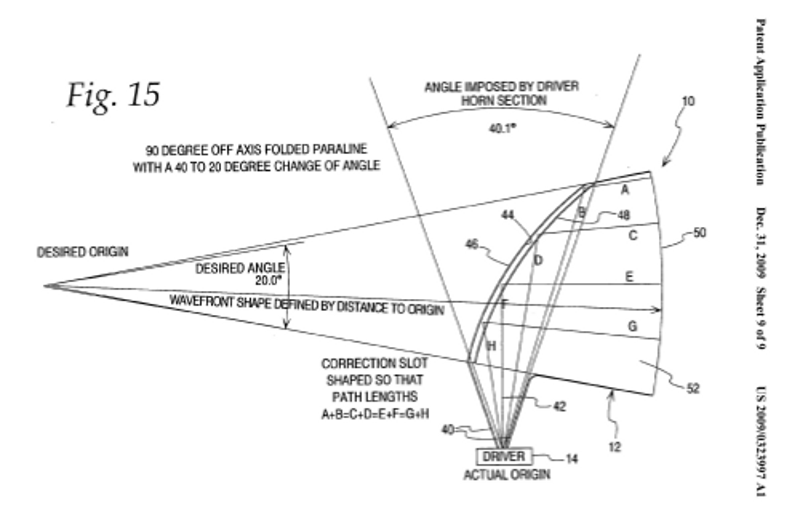
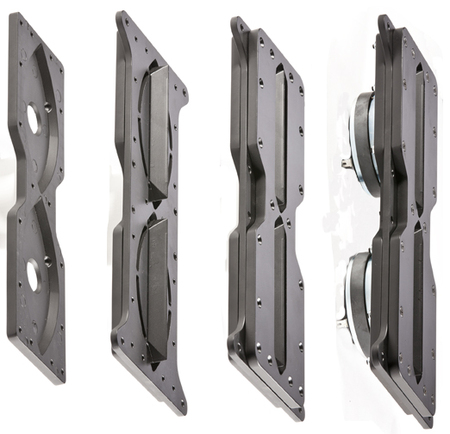
2) The Paraline lens, designed by Danley Sound Labs
Maintaining the expansion of the horn through the corner parabola is the tricky part to lay out.How much does the expansion of the horn affect this curve?
You can use a piece of string to determine the arc and keep the path length the same.
Danley's patent below is similar to what you should try to accomplish, but the horn after the bend should only be a bit less in width than line "E".
Attachments
This gives more guts, the previous clip was more marketeering:Hi Art,
I wish I could read the rest of where that clip you posted, came from.
I'm developing a reaction-canceling horn throat mid-bass, and this seems to make sense.
http://www.khabdha.org/wp-content/u...gh-level-concert-sound-reinforcement-1986.pdf
Yes, getting the bends right is tricky 🙂.
The one you show results in two different path lengths, which will result in nasty peaks and dips, as well as an erratic polar response.
I see now what you meant to say by 'two different path lengths'
so that means asymmetric horn mouth should be avoided ... though, then there is the floor, or maybe a wall ...

This gives more guts, the previous clip was more marketeering:
http://www.khabdha.org/wp-content/u...gh-level-concert-sound-reinforcement-1986.pdf
Art, plenty of useful info in that, for sure. Thanks kindly !
I really should have wrote "an infinite multiple of path lengths", but it was easier to draw in just two.I see now what you meant to say by 'two different path lengths'
so that means asymmetric horn mouth should be avoided ... though, then there is the floor, or maybe a wall ...
An asymmetric horn mouth does not have to have multiple path lengths, while in the Dave Gunness mode you could look up his "VariIntense" horns, which have narrow dispersion on top, and wider at the bottom to properly cover a deep room without too much side wall reflections and maintain even front to back intensity level.
I really should have wrote "an infinite multiple of path lengths", but it was easier to draw in just two.
the floor not included
I took for granted it would be placed directly on the floor, and another big horn placed above
Hmm. Is that the horn that you're working on tinitus?
The ones I have will be 18" (45.72cm) above the floor, with a flat square panel in-between.
Since Patrick Bateman has shown the Paraline again, I've started thinking. Sorry that I'm all over the place, but could it be used to reduce the length of the horn enough to be worth considering?
It's been a while since I've seen Patrick's video on his description of the compression driver-based implementation.
Art, with your Paraline configuration with the Alpha 8 drivers, how much of the horns did they 'replace'?
The ones I have will be 18" (45.72cm) above the floor, with a flat square panel in-between.
Since Patrick Bateman has shown the Paraline again, I've started thinking. Sorry that I'm all over the place, but could it be used to reduce the length of the horn enough to be worth considering?
It's been a while since I've seen Patrick's video on his description of the compression driver-based implementation.
Art, with your Paraline configuration with the Alpha 8 drivers, how much of the horns did they 'replace'?
Ok, so after watching Patrick's video again with his proof of concept, I'm starting to wonder this: Could I combine the Alpha 8 and the Pyle PDS521 into a Paraline?!
JLH's design is pretty nice...I wonder what it would require in order to get it down to 125Hz or so...a 'horn' a few inches deep certainly would be better than 25!
If so, how do I model this in HornResp? I'll have to start reading Square Pegs again 🙂
JLH's design is pretty nice...I wonder what it would require in order to get it down to 125Hz or so...a 'horn' a few inches deep certainly would be better than 25!
If so, how do I model this in HornResp? I'll have to start reading Square Pegs again 🙂
my workshop is frosen, and no wood work right now
hmm, paraline you say ?
don't know
but not sure I would put my tweeter in there
but thinking about a paraline midrange
making it kind of like a compression driver
maybe MTM design could be a way to combine paraline midrange with small tweeter horn
btw, if your midbass horn is lifted from the floor I would not use any of what I suggested
only intended for placing directly on the floor
hmm, lifted from the floor ? ... maybe think about one with the driver mounted below
hmm, paraline you say ?
don't know
but not sure I would put my tweeter in there

but thinking about a paraline midrange
making it kind of like a compression driver
maybe MTM design could be a way to combine paraline midrange with small tweeter horn
btw, if your midbass horn is lifted from the floor I would not use any of what I suggested
only intended for placing directly on the floor
hmm, lifted from the floor ? ... maybe think about one with the driver mounted below
The ones I have will be 18" (45.72cm) above the floor, with a flat square panel in-between.
then maybe something like the first I suggested would still work
changed it a bit(drawing shows horn seen from above)
Attachments
None, the length is the same as if it were a standard conical horn.Art, with your Paraline configuration with the Alpha 8 drivers, how much of the horns did they 'replace'?
I use the Paraline because in a line array PA the HF must have very narrow dispersion to avoid interference patterns from adjacent horns.
The Paraline is great in that regard, but it imparts a ragged frequency response.
I would not consider it for single driver use, and if you look at the DSL product line, they do not use Paralines in any single driver applications either.
Not to put a damper on your project, but an Alpha 8 in a small sealed or ported box can do 110 dB with just 50 watts, and have smoother response than in any horn.
OSHA limits exposure of 110 dBA Slow to only half an hour a day, longer than that statistically will cause hearing damage.
A small horn can give you another 3-6 dB on axis, but do you actually listen loud enough to warrant the extra real estate it takes up?
- Status
- Not open for further replies.
- Home
- Loudspeakers
- Multi-Way
- Midbass horn
